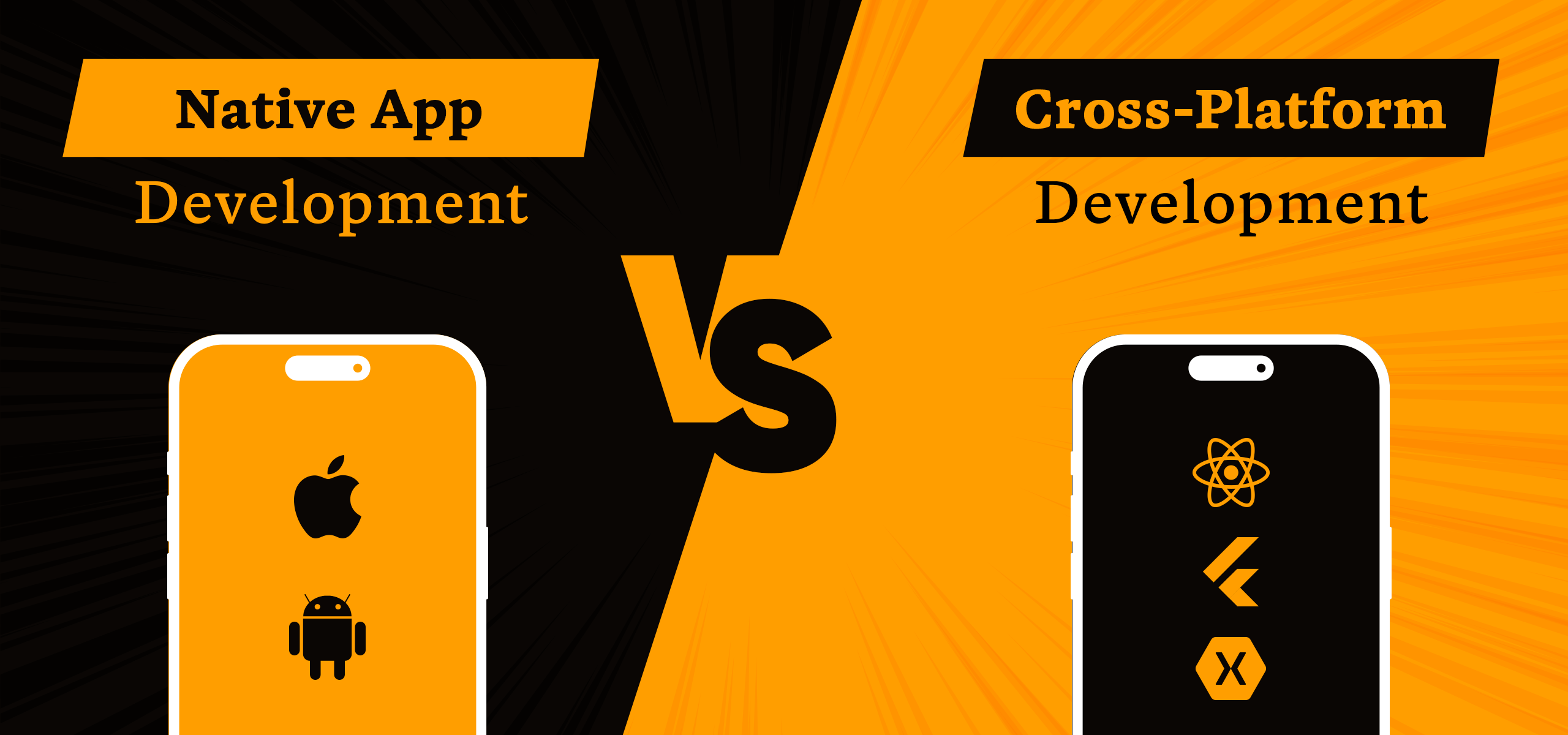Posted on
July 11, 2023
Updated on
March 20, 2024
Read time
 13 mins read
13 mins read
Choosing a development approach — native vs. cross-platform — is among the most crucial decisions you’ll make for your mobile app. Although both these options are viable, success hinges on selecting the one that best suits your app requirements and business objectives.
In this article, we’ll closely examine the benefits and considerations of native and cross-platform mobile app development, helping you make an informed choice. So get ready to understand both development approaches and uncover the possibilities each brings to the table. Let’s dive in.
What is native mobile app development?
Native mobile app development refers to creating applications specifically for a particular platform or operating system. Depending on the operating system you choose, your application is coded in the platform-specific programming language and framework.
Native Android apps require Java or Kotlin programming languages. While for iOS apps, Objective-C and Swift are used. Further, native applications also require their own platform-specific software development kits (SDKs) and integrated development environments (IDE). For Android, you need to use Android Studio or IntelliJ IDEA, and for iOS apps you need Xcode or AppCode as your IDE.
Some popular examples of native mobile apps that we use every day are Google Maps, Pinterest, Spotify, and WhatsApp.
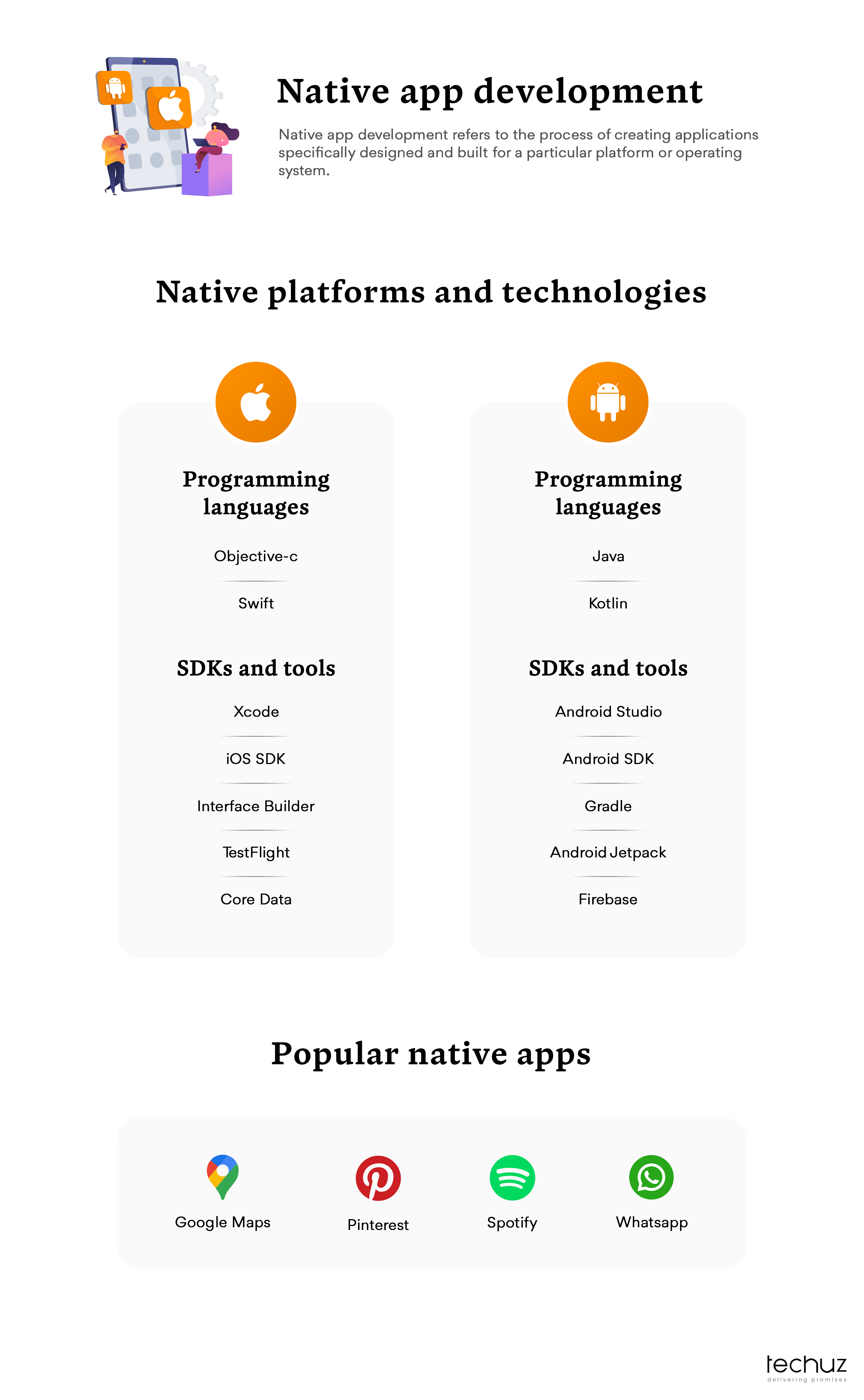
Advantages of native mobile app development
Native app development brings with it a range of advantages. These include the following:
1. Superior loading speed
Native application development prioritizes fast loading speed to enhance user experience. By utilizing platform-specific resources and compiling code into machine language, native apps achieve optimized performance. Direct access to native APIs enables efficient data retrieval and processing, resulting in quicker loading times. Effective resource management, asynchronous operations, minimized network latency, and optimized asset loading techniques further contribute to speedy loading.
These approaches reduce interpretation overhead, maximize system resource utilization, and minimize network delays. Fast loading speed plays a vital role in reducing user frustration, improving engagement, and ensuring a seamless user experience in mobile applications.
2. Robust offline support
One of the primary advantages of a native application is that it works perfectly even without an internet connection. It provides more convenience to users as they can access all the functions of the app in airplane mode or offline environment. This offline support function is important for users who live on a low internet connection, are in remote locations, or have limited data.
3. More intuitive and interactive
Native apps, being built specifically for a particular operating system (OS), provide an optimized user experience that is perfectly compatible with that OS. This compatibility allows the app to adhere to the design guidelines and instructions of the OS, resulting in a more intuitive and familiar user interface. Users can interact with the app using gestures and actions that are already familiar to them, enhancing the overall usability and interactivity of the application.
4. Better Code Debugging
Native app’s platform-specific approach also aids in better code debugging. These apps being specifically developed for a particular platform or operating system makes them less sensitive to the platform or SDK updates and changes, resulting in a smooth debugging process. In contrast, cross-platform applications may encounter challenges due to their need to be compatible with multiple programming languages and operating systems.
5. Excellent performance
Native mobile app development involves building and optimizing apps for a specific platform, resulting in a high level of performance. Native apps are known for being fast and responsive because they are designed specifically for a particular operating system and integrated using the platform’s core programming language and APIs. This focused approach enhances the efficiency of the application.
Further, native apps leverage the device’s processing speed and utilize efficient storage mechanisms, resulting in faster load times and a smoother user experience. The use of platform-specific programming languages and APIs enables optimized access to device storage in native app development.
Cross-platform apps also utilize device storage, but their implementation and level of optimization may vary depending on the framework used. And while advancements have been made in cross-platform development, native apps still have an advantage in achieving faster load times because of their platform-specific optimization.
6. Enhanced Security
Native apps offer enhanced security compared to other development approaches. This is because native applications are tightly integrated with the platform they are built for, allowing them to leverage platform-specific security features. For example, iOS native apps can utilize Secure Enclave, a hardware-based security feature, to protect sensitive data like passwords and cryptographic keys.
This hardware-based security makes it more challenging for attackers to access such data, even if they compromise the device. Further, native apps follow the platform’s guidelines and conventions, which facilitates easier review and auditing of security vulnerabilities. This scrutiny helps in identifying and addressing potential security issues before the app is released.
Disadvantages of native app development
Here are some drawbacks of native app development that you should consider:
1. No Code Reusability
Native app development requires separate coding and development for each mobile operating system, such as iOS and Android. This lack of code reusability means that significant time, effort, expenses, and resources are required to develop applications for each platform. In contrast, cross-platform apps have a shared code base that can be used for multiple platforms offering the advantage of code reusability.
2. More maintenance and update efforts
Not only do native app requires separate development but also maintenance efforts. Any bug fixes, performance enhancements, or feature addition have to be implemented separately for each platform, leading to double efforts.
3. Longer development time and higher cost
Separate development efforts for native apps result in longer development durations. With separate codebases, testing processes, and technical implementations for each platform, the overall development time increases. This extended development timeline is accompanied by higher costs due to the need for different teams with expertise in respective technologies. Allocating resources and coordinating development efforts for multiple platforms can add complexity and increase overall expenses.
4. Hiring and managing challenges
Developing native apps for different platforms requires hiring separate developers or teams with specialized knowledge. This can increase the effort and challenges involved in finding the right developers with the necessary expertise. Managing multiple teams and coordinating their efforts also adds complexity to the development process, requiring effective project management and communication.
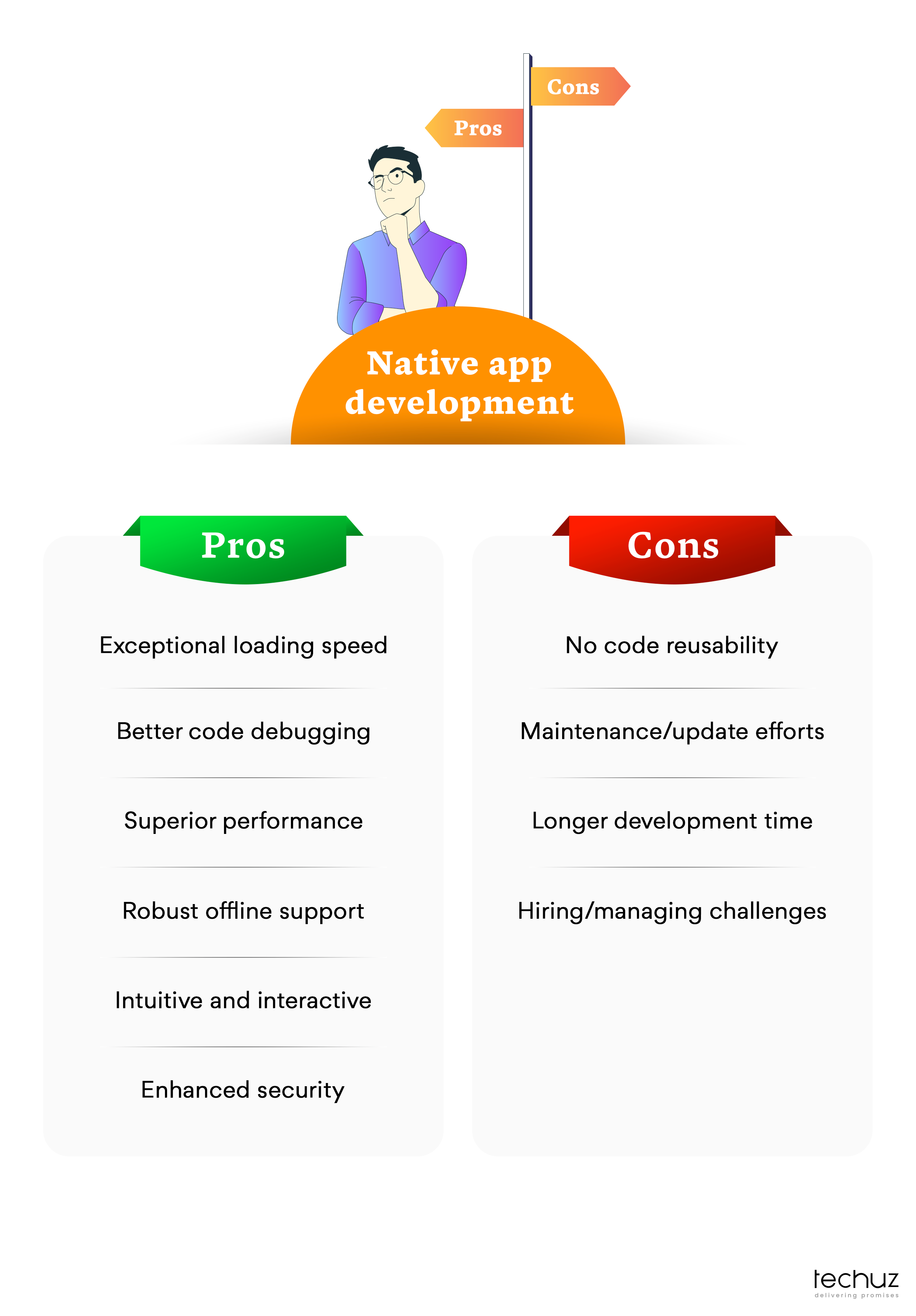
What is cross-platform app development?
Cross-platform app development involves building a mobile app with a single codebase that can support and run on multiple platforms. This is made possible with cross-platform frameworks that use platform-specific SDKs, such as Android SDK or iOS SDK, through a unified API. These frameworks abstract the underlying platform SDK, providing access to various sensors like GPS, battery level, camera, and microphone. By accessing various platform SDKs and libraries, this approach simplifies the development process and allows for code reuse across multiple platforms.
Further, cross-platform mobile apps can be designed to resemble a native look and feel by integrating native UI elements. This integration helps the app closely resemble the native apps of the target platforms.
Flutter, React Native, Xamarin, and Ionic are some of the popular frameworks. In particular, Flutter and React Native are the most prominent in the cross-platform development market. Many notable apps that we use every day are developed using these frameworks. These include Discord, Microsoft Office, Sound Cloud Pulse, and Airbnb.
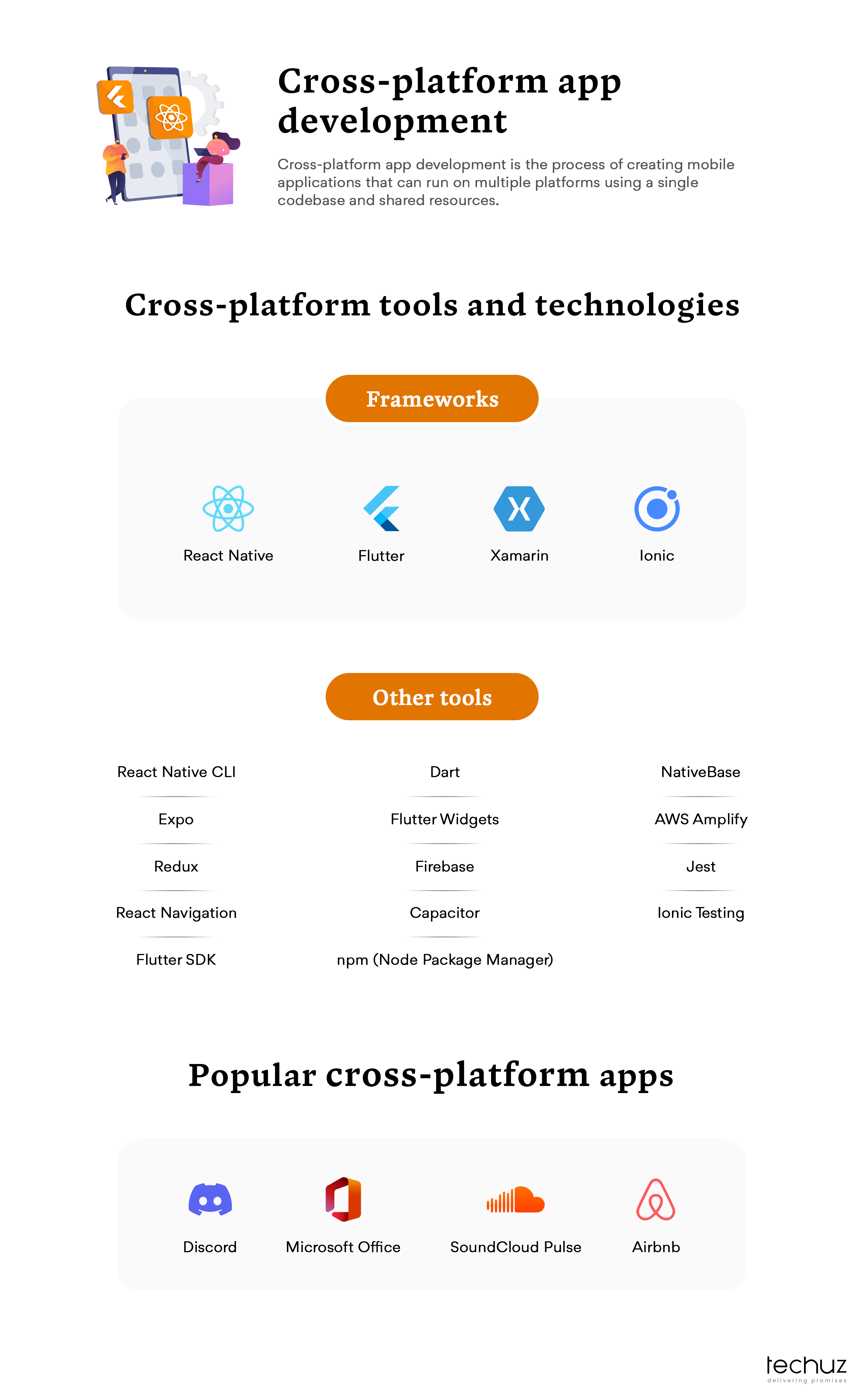
Advantages of cross-platform app development
Cross-platform app development comes with the following host of advantages:
1. Code reusability
The key benefit of cross-platform development is the ability to create a single codebase that can be used for multiple app platforms. This significantly saves time and effort as the development team can work on both platforms simultaneously. For example, when coding an application for iOS devices, developers can easily compile it for Android (and vice versa) in a relatively short time. The extent of code sharing between platforms depends on the integration of native modules into the application.
2. Fast development process and time-to-market
Cross-platform application development streamlines the development process by utilizing a single codebase. This eliminates the need for separate Android and iOS projects. Operationally, this approach speeds up development as the production, design, and engineering teams collaborate on a single project. The merged effort allows businesses to bring their app to market faster, across multiple platforms, and seize opportunities more efficiently.
3. Reduced development costs
Cross-platform app development offers value for money and reduced costs compared to native development. By requiring only one development team instead of separate teams for each platform, businesses can achieve cost savings to a significant extent. With cross-platform frameworks, developers can reuse large portions of code and assets across both platforms. This code reuse shortens the development process, resulting in reduced overall mobile app development costs.
4. UI/UX consistency across platforms
Native app development often requires separate and specialized teams due to the variations in UI and navigation design across different operating systems and platforms. In contrast, cross-platform development frameworks inherently handle these differences. Cross-platform apps offer a more consistent look and feel for users across multiple platforms, ensuring a cohesive user experience regardless of the operating system or device.
This is especially helpful for apps where their users use them on multiple devices. It enables organizations to display a consistent brand identity across a wide range of platforms without much additional effort. For example, when the development team changes the visual style of an app, that change is immediately visible across the platforms.
5. Broad market reach
Cross-platform development offers businesses the advantage of reaching a broader market by deploying apps on multiple platforms. The cost-effectiveness and efficiency of cross-platform development allow businesses to target a larger customer base or user audience effectively. This is particularly beneficial for businesses that are in the testing phase, as it enables them to deploy the minimum viable product across multiple platforms and gather feedback from a diverse range of users.
Disadvantages of cross-platform app development
The following are the challenges of cross-platform app development:
1. Performance considerations
Generally speaking, developers have long recognized that native apps perform slightly better and faster than cross-platform apps. Because cross-platform applications require an additional abstraction layer and rendering process, they are typically slower than native applications. Additionally, when it comes to CPU and GPU-intensive applications, there’s a wider performance difference, with native performing way better. However, it’s worth noting that there have been advancements in cross-platform frameworks and optimization techniques that have been reducing the performance gaps between the two.
2. Limitations in functionality adaptation
Cross-platform applications need to adapt their design and functionality to suit specific platforms, operating systems, and devices. This adaptation process can be demanding for developers, requiring significant effort to handle individual differences across various devices and platforms. Complex features, in particular, may pose challenges in ensuring consistent functionality across different platforms. These difficulties in adapting code and ensuring consistent functionality might affect the performance and implementation process.
3. Longer wait for updates and new features
Cross-platform apps may experience delays or require additional time and effort to support the latest updates or new features introduced by operating systems. Native applications receive updates to their software development kits (SDKs) faster than cross-platform frameworks. This means the latter can face potential delays in incorporating new functionalities or taking advantage of the latest platform enhancements.
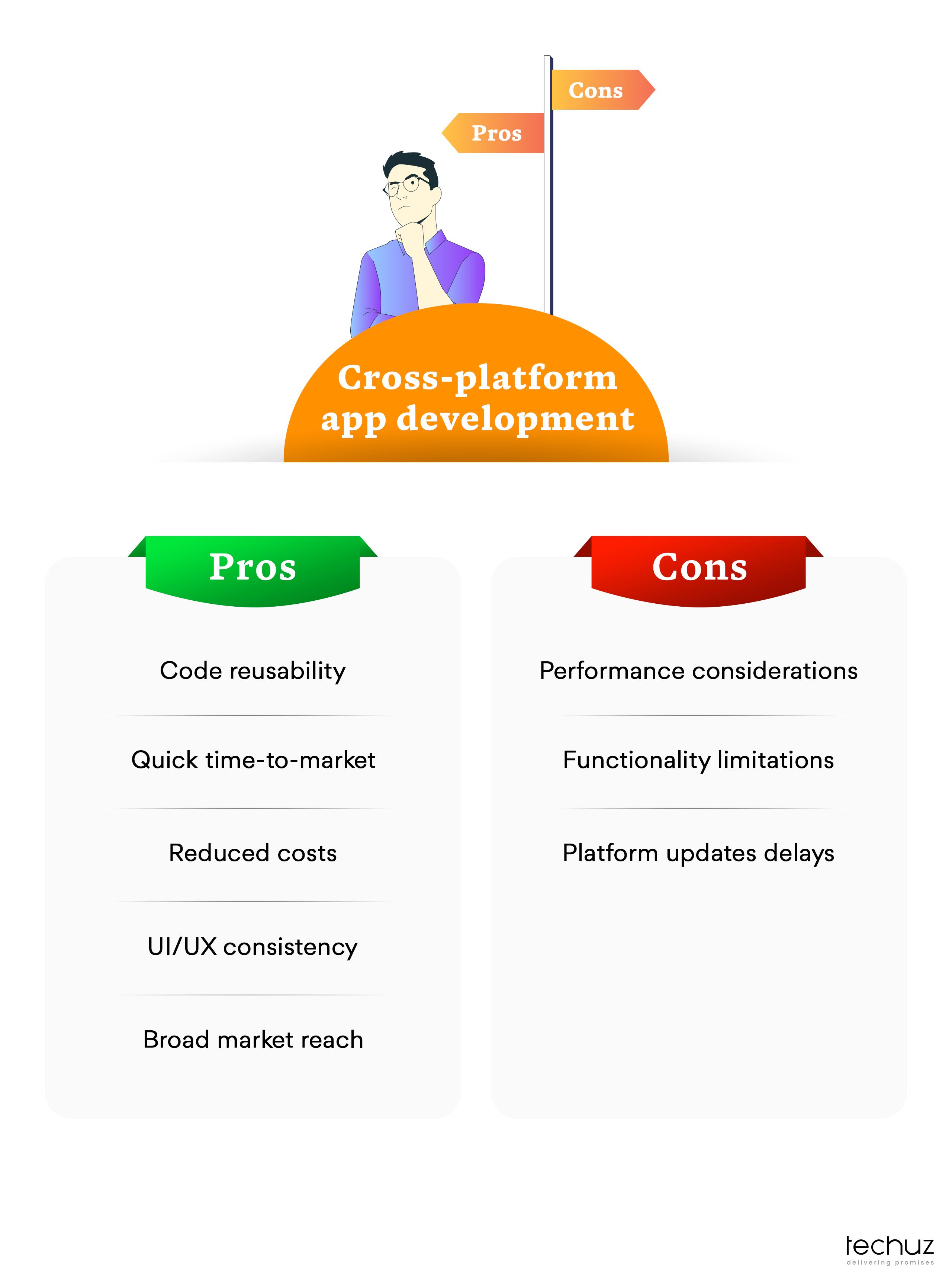
Native vs cross-platform: Which is the right approach for you?
The decision to develop a native or cross-platform application is crucial and depends on several factors. Both options have their own benefits and considerations, and careful evaluation is necessary to determine the best approach for your business. Factors to consider include your budget, development timeline, performance requirements, and security considerations. By considering these areas, you can make an informed decision on which development method to use for your application. Let’s understand these factors in detail:
- Target audience: Conduct thorough research on your target users and their mobile platform preferences. If your target audience predominantly uses a specific platform, developing a native app for that platform instead of a cross-platform app is a better decision. This allows you to provide your users with a more optimized and seamless user experience while potentially saving costs associated with developing for multiple platforms.
- Development budget: Does your budget allow you to develop separate native apps for both platforms? If yes, native is the way to go. If not, cross-platform development will be more cost-effective, allowing you to code reuse and reducing the need for separate development teams.
- Development timeline: When targeting multiple platforms, cross-platform development can be a faster way to bring your app to market. On the other hand, native development may take longer due to the need to build separate codebases for each platform.
- App Complexity and Performance: Assess the complexity and performance requirements of your app. If your app requires intensive processing or relies on specific hardware capabilities, native development is more suitable.
- UI/UX Requirements: Consider your app’s UI/UX requirements, such as the impact of maintaining a uniform design or adhering to platform guidelines on user experience and app functionality. Cross-platform development offers a consistent UI/UX across platforms, ensuring a uniform look and feel of the app. Native development allows for platform-specific design and interactions, tailoring the app to each platform’s guidelines and user expectations.
- Third-party integrations: Consider the need for third-party integrations. Some integrations may be better supported in one development approach than the other, so assess the compatibility and availability of necessary integrations. You can determine this earlier when documenting your app requirements.
- Maintenance and updates: Consider the long-term maintenance and update requirements. Native apps may require separate updates for each platform, while cross-platform apps allow for simultaneous updates across platforms. Maintenance and updates will also directly impact the development timeline and costs after the app’s launch.
Conclusion
Native vs cross-platform app development — which one is better? Well, now you must have understood both development approaches can be great in their own way. What really matters is your app and business requirements. Here’s a quick recap.
Choose native app development when:
- You need to leverage platform-specific features and performance optimizations.
- The app requires extensive UI customization and adherence to platform design guidelines.
- You have a dedicated budget and resources for separate development efforts.
- Security is a top priority, especially when dealing with sensitive user data.
- You anticipate future scalability and flexibility for platform-specific updates and advancements.
Choose cross-platform app development when:
- Time-to-market is crucial, and you want to reach multiple platforms simultaneously.
- Code reusability and cost efficiency are essential, especially for simpler applications.
- UI/UX consistency across platforms is a priority.
- You have a limited budget or resources for development and maintenance.
- Regular updates and feature parity across platforms are manageable without sacrificing performance.
If you’re still uncertain about choosing between native vs cross-platform mobile app development, or if you need a clearer understanding of your app requirements to make the best decision, feel free to contact us.
